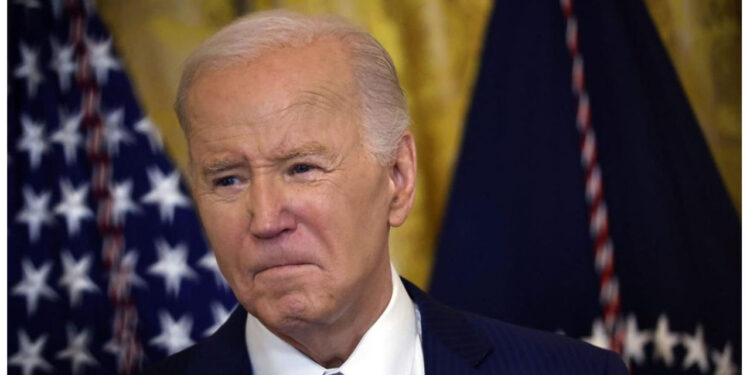Economists were taken by surprise on Thursday as new data unveiled signs of continuing inflation and a slowdown in the growth of the U.S. economy. The Bureau of Economic Analysis reported that the real gross domestic product (GDP) only increased by 1.6% compared to the previous year in the first quarter. This figure fell significantly short of economists’ projected growth rate of 2.5% and marked a substantial decline from the 3.4% growth observed in the fourth quarter of last year.
In the first three months of this year, the core personal consumption expenditures (PCE) price index, which excludes more volatile food and energy prices, experienced a surge from 2% in the fourth quarter of 2023 to 3.7%. This significant increase easily surpassed the predicted inflation rate of 2.1% that was forecasted by the Survey of Professional Forecasters in February. The Federal Reserve closely monitors this inflation gauge, making it a key indicator of economic performance.
David Donabedian, the Chief Investment Officer of CIBC Private Wealth U.S., expressed his views on the report, stating that it was a disappointing combination of slower growth and higher inflation. In an email to Fortune, he referred to it as the “worst of both worlds” report.
According to a note by Citi economists, led by Veronica Clark, they share the same view that the Fed’s preferred inflation measure will probably increase to 2.8% when the data for March is released on Friday. This will likely push central bank officials towards a more cautious stance. Consequently, Clark and her team anticipate that the first interest rate cut will take place in July, rather than June. However, they still believe that the markets are mistaken in completely ruling out any interest rate cuts for the remainder of the year.
Fiscal stimulus support is gradually diminishing, and there is a decline in spending on goods, which is causing concerns about economic growth. As the Federal Reserve contemplates whether to cut interest rates or maintain them at higher levels, these concerns are likely to have an impact. Clark expressed the belief that the Fed will opt for rate cuts during the summer, even before inflation shows signs of a sustainable slowdown.
Investors showed a clear focus on the signs of persistent inflation in the first quarter GDP report on Thursday. However, they appeared less optimistic about the possibility of market-boosting rate cuts in the upcoming summer. By midday Thursday, the Dow Jones industrial average declined by 1.5% as investors processed the first quarter GDP report. Likewise, the S&P 500 fell by 1.1%, and the tech-heavy Nasdaq Composite plummeted by 1.5%.
According to EY chief economist Gregory Daco, the first quarter GDP report has debunked the theory of a “no landing” scenario with stronger economic growth and slightly higher inflation. Daco argues that this report undermines the misleading narratives of an economy that is picking up steam.
Daco is of the opinion that economic growth will continue to slow down in the second quarter due to persistent inflation, restricted credit conditions, and a decline in labor demand. He emphasizes the significance of inflation and warns that if it proves to be more persistent than expected, it could have a notable negative impact on the economy. This includes reduced real income growth, a prolonged “higher for longer” Federal Reserve stance, and tighter financial conditions.
According to David Russell, the global head of market strategy at TradeStation, the U.S. economy may potentially be confronted with an economic scenario reminiscent of the 1970s, which he describes as a nightmare.
According to an email statement to Fortune, there is a growing concern about stagflation due to the recent GDP miss and the unexpected rise in the price index. The weak growth accompanied by persistent inflation raises questions about the sustainability of the trend towards lower prices. Jamie Dimon, the CEO of JPMorgan Chase, also expressed his views to the Wall Street Journal, highlighting that stagflation is a risk that cannot be overlooked by the Federal Reserve.
A caveat to the weak GDP data
The weak growth statistics in the first quarter GDP report were undoubtedly concerning. However, it is important to consider some caveats. One of them is that private domestic demand, which measures real final sales to domestic purchases, actually increased by 3.1% during this period. According to William Blair analyst Richard de Chazal, the growth in real private domestic investment is encouraging, as it tends to be a strong leading indicator for future near-term GDP growth.
Spending on health care, financial, insurance, and other services continued to increase in the initial months of this year, despite a slowdown in spending on goods. This indicates that there is still strong demand for these services.
In a note on Thursday, Paul Ashworth, the chief North America economist at Capital Economics, explained that the first quarter’s GDP growth was significantly impacted by the increase in imports compared to exports. This obscured the underlying economic momentum that was present.
According to the expert, the increase in exports was only 0.9%, which highlights the influence of the weak global demand. On the other hand, imports witnessed a significant surge of 7.2%. As a result, net exports had a negative impact on GDP growth, subtracting almost 0.9% points. Additionally, inventories further contributed to this drag, subtracting nearly 0.4% points.
The first quarter GDP growth figures may not fully reflect the true strength of the economy due to certain limitations. This suggests that there might be more underlying economic resilience than initially indicated. Such an observation is encouraging for both consumers and businesses. However, it also means that the Federal Reserve is unlikely to lower interest rates in the near future. According to William Blair’s de Chazal, this decision is influenced by the overall acceptable level of demand, but concerns still remain regarding uncomfortably high levels of inflation.










